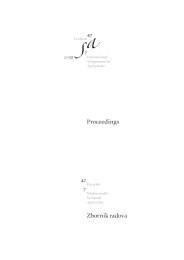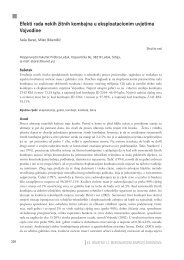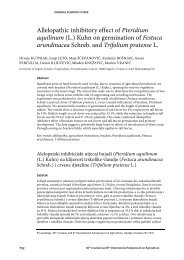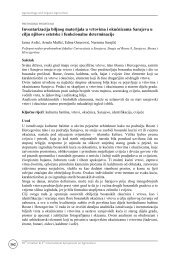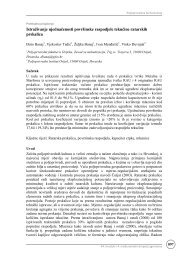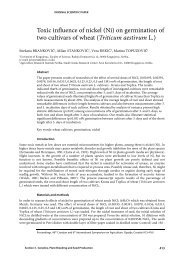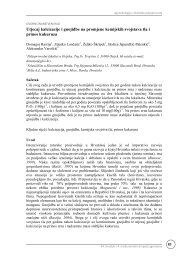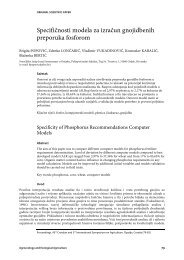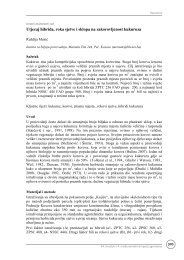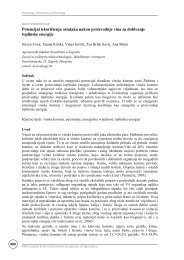43rd Croatian and 3rd International Symposium on Agriculture - hr
43rd Croatian and 3rd International Symposium on Agriculture - hr
43rd Croatian and 3rd International Symposium on Agriculture - hr
You also want an ePaper? Increase the reach of your titles
YUMPU automatically turns print PDFs into web optimized ePapers that Google loves.
Effect of Fertilizati<strong>on</strong> ORIGINAL <str<strong>on</strong>g>and</str<strong>on</strong>g> SCIENTIFIC Liming <strong>on</strong> Crop PAPER<br />
Resp<strong>on</strong>ses<br />
Effect of Fertilizati<strong>on</strong> <str<strong>on</strong>g>and</str<strong>on</strong>g> Liming <strong>on</strong> Crop<br />
Resp<strong>on</strong>ses<br />
Imre KÁDÁR, Peter RAGÁLYI<br />
Research Institute for Soil Science <str<strong>on</strong>g>and</str<strong>on</strong>g> Agricultural Chemistry, H-1022 Budapest, Herman Ottó Str. 15, Hungary<br />
(e-mail: kadar@rissac.hu)<br />
Abstract<br />
The paper reports results achieved in the first 30 years of a 45-year-old field trial for fertilizati<strong>on</strong><br />
<str<strong>on</strong>g>and</str<strong>on</strong>g> liming set up <strong>on</strong> acid s<str<strong>on</strong>g>and</str<strong>on</strong>g>y brown forest soil in the Nyírség regi<strong>on</strong>. The site was poor in all<br />
five major nutrients (N, P, K, Ca, Mg). The following c<strong>on</strong>clusi<strong>on</strong>s could be drawn:<br />
Fertilizer resp<strong>on</strong>ses were time dependent. In the 1st decade of the experiment N al<strong>on</strong>e increased<br />
the potato <str<strong>on</strong>g>and</str<strong>on</strong>g> rye yields. In the 2nd decade, the yield <strong>on</strong> N-plots declined near to c<strong>on</strong>trol. In the<br />
studied last few years, the yields <strong>on</strong> N-plots were negligible, the soil lost its fertility <str<strong>on</strong>g>and</str<strong>on</strong>g> became<br />
leached <str<strong>on</strong>g>and</str<strong>on</strong>g> very acid. To maintain or increase the yields of crops NPKCaMg fertilizati<strong>on</strong> was<br />
needed. Fertile plots have a pH (KCl) 5.5-6.0, 120-150 mg/kg amm<strong>on</strong>iumlactate-soluble P2O5<br />
<str<strong>on</strong>g>and</str<strong>on</strong>g> K2O in ploughed layer <str<strong>on</strong>g>and</str<strong>on</strong>g> require the applicati<strong>on</strong> of about 150 kg N <str<strong>on</strong>g>and</str<strong>on</strong>g> 1 t/ha ground<br />
dolomite yearly.<br />
Key words: liming, fertilizati<strong>on</strong>, l<strong>on</strong>g-term field experiment, crop resp<strong>on</strong>ses<br />
Introducti<strong>on</strong><br />
There is a nearly universal acceptance of the fact that most l<strong>on</strong>g-term ecological research is inherently<br />
interdisciplinary in nature. The successful performance of l<strong>on</strong>g-term field experiments requires the special<br />
recogniti<strong>on</strong> of certain key elements in the work. The scientific questi<strong>on</strong>s <str<strong>on</strong>g>and</str<strong>on</strong>g> objectives must be clearly<br />
defined <str<strong>on</strong>g>and</str<strong>on</strong>g> stated because they must guide research for several generati<strong>on</strong>s of scientists, administrators <str<strong>on</strong>g>and</str<strong>on</strong>g><br />
funding agencies.<br />
Every human use of the natural ecosystem results in the removal of material <str<strong>on</strong>g>and</str<strong>on</strong>g> embodied energy which are<br />
later not returned or broken down at the same place. This means that human uses change natural ecosystems<br />
t<strong>hr</strong>ough different forms of matter <str<strong>on</strong>g>and</str<strong>on</strong>g> energy transports, involving removal or supply. L<strong>on</strong>g-term field<br />
experiments are vital in order to represent cumulative effects <str<strong>on</strong>g>and</str<strong>on</strong>g> unusual events caused by human use,<br />
agricultural practice, such as cultivati<strong>on</strong>, manuring etc.<br />
L<strong>on</strong>g-term field experiments make visible processes <str<strong>on</strong>g>and</str<strong>on</strong>g> events often invisible in most short-term<br />
experiments. As Magnus<strong>on</strong> et al. (1983) stated: "Because we are unable to directly sense these slow changes<br />
<str<strong>on</strong>g>and</str<strong>on</strong>g> because we are even more limited in our abilities to interpret cause <str<strong>on</strong>g>and</str<strong>on</strong>g> effect relati<strong>on</strong>s for these slow<br />
changes, processes acting over decades are hidden <str<strong>on</strong>g>and</str<strong>on</strong>g> reside in the invisible present". This is the time scale<br />
of acid depositi<strong>on</strong>, the introducti<strong>on</strong> of synthetic chemicals, acidificati<strong>on</strong> of soils, air borne polluti<strong>on</strong> <str<strong>on</strong>g>and</str<strong>on</strong>g><br />
climate changes made by man.<br />
The various experiments at Rothamsted, including both the classic <str<strong>on</strong>g>and</str<strong>on</strong>g> modern, symbolize the value of l<strong>on</strong>gterm<br />
studies in general. The original goals of several of these experiments have l<strong>on</strong>g since been fulfilled.<br />
However, they c<strong>on</strong>tinue to be of value as dem<strong>on</strong>strati<strong>on</strong>s, <str<strong>on</strong>g>and</str<strong>on</strong>g> as sources of c<strong>on</strong>tinuing insight into<br />
agricultural practice (Johnst<strong>on</strong> 1989). In Hungary, most l<strong>on</strong>g-term field experiments are less than 40 years<br />
old, though this number has been increasing since the late 1980’s, as the regi<strong>on</strong>al research stati<strong>on</strong>s <str<strong>on</strong>g>and</str<strong>on</strong>g><br />
institutes were established in the late 1950’s <str<strong>on</strong>g>and</str<strong>on</strong>g> 1960’s (Láng, 1973).<br />
Proceedings. 43 rd <str<strong>on</strong>g>Croatian</str<strong>on</strong>g> <str<strong>on</strong>g>and</str<strong>on</strong>g> 3 rd <str<strong>on</strong>g>Internati<strong>on</strong>al</str<strong>on</strong>g> <str<strong>on</strong>g>Symposium</str<strong>on</strong>g> <strong>on</strong> <strong>Agriculture</strong>. Opatija. Croatia (531-534)<br />
Field Crop Producti<strong>on</strong> 531
532<br />
Imre KÁDÁR, Peter RAGÁLYI<br />
Materials <str<strong>on</strong>g>and</str<strong>on</strong>g> methods<br />
The trial was established in autumn 1962 <strong>on</strong> a brown forest soil, acid s<str<strong>on</strong>g>and</str<strong>on</strong>g> with thin interstratified layers of<br />
colloids <str<strong>on</strong>g>and</str<strong>on</strong>g> sesquioxide accumulati<strong>on</strong> called “kovárvány”. The soil has a particle-size distributi<strong>on</strong> in<br />
ploughed layer as follows: s<str<strong>on</strong>g>and</str<strong>on</strong>g> over 0.05 mm 70-85%, loam 0.05-0.002 mm 8-20%, clay under 0.002 mm 3-<br />
6%. Clay in colloid accumulati<strong>on</strong> layers makes up to 10-18%. The saturati<strong>on</strong> percentage was 25-30, pH (H2O)<br />
5.4, pH (KCl) 4.3, humus 0.5-0.8%, CEC 3-5 meq/100g. The site is situated about 100 m above sea-level with<br />
yearly precipitati<strong>on</strong> of 550-600 mm <str<strong>on</strong>g>and</str<strong>on</strong>g> sunny hours 1900-2000 h/year. The min/max temperature was about<br />
–25 Cº <str<strong>on</strong>g>and</str<strong>on</strong>g> +35 Cº interval, the watertable level found at a depth of 2-3 m. The site is extremely drought<br />
sensitive. The site was poor in all five major nutrients N, P, K, Ca, Mg (Baranyai et al., 1987; Kádár <str<strong>on</strong>g>and</str<strong>on</strong>g><br />
Szemes, 1994).<br />
The trial has 32 treatments x 4 replicati<strong>on</strong> = 128 plots with 5 x 10 = 50 m2 plot size <str<strong>on</strong>g>and</str<strong>on</strong>g> r<str<strong>on</strong>g>and</str<strong>on</strong>g>omized block<br />
design. The forms of fertilizers applied were Ca-amm<strong>on</strong>ium nitrate, superphosphate, muriate of potash,<br />
powdered limest<strong>on</strong>e <str<strong>on</strong>g>and</str<strong>on</strong>g> dolomite. The crop sequence was potato-rye in the first 10 years, than potato-winter<br />
wheat (8 years), than followed different crops the next 10 years (like white lupine, sunflower, grasses, spring<br />
barley, tobacco). In 1991, the 29th year of the trial, a triticale m<strong>on</strong>oculture was established which is now 16<br />
years old. The nutrients applied in the trial are shown in Table 1.<br />
The plant material was analysed after wet ashing with cc.HNO3 + cc.H2O2, for the N determinati<strong>on</strong> with<br />
cc.H2SO4 + cc.H2O2 treatment. All the mineral elements were measured using ICP techniques. The<br />
composite soil samples per plots were made of 20 subsamples, the composite plant samples were made of 1<br />
m2 plant material per plot. Material <str<strong>on</strong>g>and</str<strong>on</strong>g> methods <str<strong>on</strong>g>and</str<strong>on</strong>g> the main results of the experiment were summarized<br />
elsewhere (Kádár, 1999, 2005).<br />
Table 1. Fertilizati<strong>on</strong> <str<strong>on</strong>g>and</str<strong>on</strong>g> liming applied in the experiment<br />
Nutrient<br />
Applied nutrients, kg/ha/year<br />
Levels N P2O5 K2O CaCO3 MgCO3<br />
0 0 0 0 0 0<br />
1 50 60 60 250 140<br />
2 100 120 120 500 280<br />
3 150 180 180 1000 -<br />
Remark: Ca-amm<strong>on</strong>ium-nitrate, superphosphate, muriate of potash, powdered limest<strong>on</strong>e <str<strong>on</strong>g>and</str<strong>on</strong>g> dolomite<br />
Results <str<strong>on</strong>g>and</str<strong>on</strong>g> discussi<strong>on</strong><br />
The value of pH (H2O) dropped down from 5.4 (c<strong>on</strong>trol) to 4.6 <strong>on</strong> the N3 plot, while lifted up to 6.8 <strong>on</strong> the<br />
limed plot. The NH4-acetate+EDTA soluble (Lakanen <str<strong>on</strong>g>and</str<strong>on</strong>g> Erviö, 1971) element c<strong>on</strong>tents in the ploughed<br />
layer mirrored the changes caused by liming <str<strong>on</strong>g>and</str<strong>on</strong>g> fertilizati<strong>on</strong>: Ca lifted up from 87 to 767, Mg from 18 to 97,<br />
P2O5 from 85 to 225, K2O from 41 to 78. So the P-supply of soil turned to a satisfactory, while the K-supply of<br />
soil still remained under a satisfactory level in the topsoil. The downward movement of K-fertilizer probably<br />
enriched partly the subsoil (Kádár <str<strong>on</strong>g>and</str<strong>on</strong>g> Rékási, 2008).<br />
In the 1 st decade of the experiment N al<strong>on</strong>e increased the potato <str<strong>on</strong>g>and</str<strong>on</strong>g> rye yields. In the 2 nd decade, the yield <strong>on</strong><br />
N-plots declined near to c<strong>on</strong>trol. In the studied last few years, the yields <strong>on</strong> N-plots were negligible, the soil<br />
lost its fertility, became leached <str<strong>on</strong>g>and</str<strong>on</strong>g> very acid. To maintain or increase the yields of crops NPKCaMg<br />
fertilizati<strong>on</strong> was needed.<br />
In the absence of l<strong>on</strong>g-term studies, serious misjudgements can occur not <strong>on</strong>ly in our underst<str<strong>on</strong>g>and</str<strong>on</strong>g>ing of<br />
events, but also in our attempts to manage our envir<strong>on</strong>ment. An example of nitrogen additi<strong>on</strong>s to plots in<br />
our old field trial at Nyírlugos makes it clear. On this s<str<strong>on</strong>g>and</str<strong>on</strong>g>y acid brown forest soil poor in humus <str<strong>on</strong>g>and</str<strong>on</strong>g><br />
nutrients, in the first decade (1963-1972) nitrogen al<strong>on</strong>e increased the potato <str<strong>on</strong>g>and</str<strong>on</strong>g> rye yield substantially. In<br />
the sec<strong>on</strong>d decade (1973-1980), yields <strong>on</strong> N plots declined dramatically to the N-c<strong>on</strong>trol levels; phosphorus<br />
<str<strong>on</strong>g>and</str<strong>on</strong>g>, in part, potassium additi<strong>on</strong>s were needed to maintain or increase the yield of different crops (Szemes<br />
<str<strong>on</strong>g>and</str<strong>on</strong>g> Kádár 1990), Table 2.<br />
During the third decade (1982-1992) nitrogen additi<strong>on</strong> al<strong>on</strong>e led to yield losses compared to the c<strong>on</strong>trol. To<br />
maintain or especially increase the yield of different crops, phosphorus, potassium, calcium <str<strong>on</strong>g>and</str<strong>on</strong>g> sometimes<br />
magnesium additi<strong>on</strong>s were needed. The main point is that the resp<strong>on</strong>se to nutrients (elements) or<br />
fertilizati<strong>on</strong> is time-dependent. This time series displays features invisible in <strong>on</strong>e- or two-year experiments.<br />
<str<strong>on</strong>g>4<str<strong>on</strong>g>3rd</str<strong>on</strong>g></str<strong>on</strong>g> <str<strong>on</strong>g>Croatian</str<strong>on</strong>g> <str<strong>on</strong>g>and</str<strong>on</strong>g> <str<strong>on</strong>g>3rd</str<strong>on</strong>g> <str<strong>on</strong>g>Internati<strong>on</strong>al</str<strong>on</strong>g> <str<strong>on</strong>g>Symposium</str<strong>on</strong>g> <strong>on</strong> <strong>Agriculture</strong>
Effect of Fertilizati<strong>on</strong> <str<strong>on</strong>g>and</str<strong>on</strong>g> Liming <strong>on</strong> Crop Resp<strong>on</strong>ses<br />
Clearly, a short-term experiment, even though its results would be repeatable <str<strong>on</strong>g>and</str<strong>on</strong>g> statistically significant,<br />
does not fully reflect the changes induced by fertilizati<strong>on</strong>. (Table 3.)<br />
In 1983 sunflower received insufficient precipitati<strong>on</strong> so after a poor st<str<strong>on</strong>g>and</str<strong>on</strong>g> development the yields were<br />
ec<strong>on</strong>omically negligible. The grass (Perennial ryegrass, Red fescue, Narrow-leaf meadow grass) dried out<br />
after the first weedc<strong>on</strong>trol-cut <str<strong>on</strong>g>and</str<strong>on</strong>g> the narrow-leaf lupine also gave negligible yields in the dry 1985 <str<strong>on</strong>g>and</str<strong>on</strong>g><br />
1986. Grass is not recommended without irrigati<strong>on</strong> <strong>on</strong> this s<str<strong>on</strong>g>and</str<strong>on</strong>g>y soil, however narrow-leaf lupine can be<br />
successfully grown in better years with precise agro-technical practice.<br />
Table 2. Effect of fertilizati<strong>on</strong> <strong>on</strong> the grain yield of cereals, t/ha. Acid brown forest s<str<strong>on</strong>g>and</str<strong>on</strong>g>y soil. Nyírlugos,<br />
1964-1982<br />
Treatments 1963 1965 1967 1969 1971 1973 1975 1977 1979<br />
Potato, variety Gülbaba Potato, variety Desirée<br />
C<strong>on</strong>trol 8.5 6.8 8.4 10.7 10.1 6.0 5.9 14.4 3.6<br />
N 12.8 15.1 13.3 14.4 14.5 11.6 12.4 15.6 9.0<br />
NP 13.5 18.5 15.2 17.2 17.4 15.6 15.5 19.4 10.9<br />
NK 13.4 16.7 15.4 17.0 16.4 14.8 12.5 22.4 10.8<br />
NPK 13.7 19.3 16.3 19.0 18.4 21.0 18.2 26.9 12.7<br />
NPKMg 13.6 19.3 16.9 20.4 19.3 19.1 17.0 28.1 12.6<br />
LSD5% 0.9 1.1 1.0 1.0 1.0 0.9 1.0 2.6 2.4<br />
Mean 12.4 14.0 14.5 16.2 16.3 14.8 13.9 22.6 11.1<br />
Treatments 1964 1966 1968 1970 1972 1974 1976 1978 1980<br />
Rye, variety Kisvárda Wheat, variety Mv 4<br />
C<strong>on</strong>trol 1.6 1.6 1.3 1.3 1.4 1.7 1.6 1.2 0.3<br />
N 2.2 2.8 2.7 2.2 2.8 1.7 1.8 2.1 0.7<br />
NP 2.2 3.3 2.9 2.3 3.1 2.9 2.6 2.4 1.1<br />
NK 2.2 2.9 2.6 2.1 2.8 1.6 1.6 2.6 0.8<br />
NPK 2.2 3.0 2.9 2.4 3.1 3.3 2.9 3.4 1.1<br />
NPKMg 2.2 3.0 2.9 2.5 3.3 2.2 2.8 3.3 1.1<br />
LSD5% 0.2 0.2 0.2 0.2 0.2 0.2 0.2 1.3 0.4<br />
Mean 2.1 2.6 2.3 2.1 2.5 2.6 2.2 2.8 1.1<br />
Treatments<br />
Table 3. Effect of fertilizati<strong>on</strong> <strong>on</strong> the grain yield of cereals, t/ha. Acid brown forest s<str<strong>on</strong>g>and</str<strong>on</strong>g>y soil. Nyírlugos,<br />
1982-1992<br />
Winter wheat Sunflower Spring barley Tobacco Winter wheat Triticale<br />
1982 1984 1987 1988 1989 1990 1991 1992<br />
C<strong>on</strong>trol 1.6 0.8 0.7 1.2 2.3 0.5 0.8 0.4<br />
N 2.7 0.6 0.4 0.9 3.3 1.1 1.6 0.4<br />
NP 3.5 1.0 0.8 1.8 3.6 1.1 4.0 0.8<br />
NK 2.6 0.8 0.5 1.0 3.2 1.0 2.0 0.4<br />
NPK 3.5 1.4 0.9 1.8 4.0 1.3 3.6 0.8<br />
NPKCa 3.9 1.8 0.9 1.9 2.9 1.0 3.9 0.8<br />
NPKMg 3.9 2.3 0.9 1.9 4.7 1.2 4.5 0.9<br />
NPKCaMg 4.2 2.6 1.0 2.2 4.9 1.5 4.9 1.0<br />
LSD5% 1.0 0.6 0.4 0.4 1.1 0.6 1.5 0.4<br />
Mean 3.3 1.4 0.7 1.6 3.6 1.1 3.2 0.7<br />
1988 – dry tobacco leaves<br />
Field Crop Producti<strong>on</strong> 533
534<br />
Imre KÁDÁR, Peter RAGÁLYI<br />
C<strong>on</strong>clusi<strong>on</strong>s<br />
The main c<strong>on</strong>clusi<strong>on</strong>s of the Nyírlugos fertilizati<strong>on</strong> <str<strong>on</strong>g>and</str<strong>on</strong>g> liming experiment are the following:<br />
Fertilizer resp<strong>on</strong>ses were time dependent. In the 1st decade of the experiment N al<strong>on</strong>e increased the potato<br />
<str<strong>on</strong>g>and</str<strong>on</strong>g> rye yields. In the 2nd decade, the yield <strong>on</strong> N-plots declined near to c<strong>on</strong>trol. In the studied last few years,<br />
the yields <strong>on</strong> N-plots were negligible, the soil lost its fertility <str<strong>on</strong>g>and</str<strong>on</strong>g> became leached <str<strong>on</strong>g>and</str<strong>on</strong>g> very acid. To maintain<br />
or increase the yields of crops NPKCaMg fertilizati<strong>on</strong> was needed. Fertile plots have a pH (KCl) 5.5-6.0, 120-<br />
150 mg/kg amm<strong>on</strong>iumlactate-soluble P2O5 <str<strong>on</strong>g>and</str<strong>on</strong>g> K2O in ploughed layer <str<strong>on</strong>g>and</str<strong>on</strong>g> require the applicati<strong>on</strong> of about<br />
150 kg N <str<strong>on</strong>g>and</str<strong>on</strong>g> 1 t/ha ground dolomite yearly.<br />
References<br />
Baranyai F., Fekete A., Kovács I. (1987). Results of the Hungarian soil nutrient status survey. (In<br />
Hungarian) Mezőgazdasági Kiadó. Budapest.<br />
Johnst<strong>on</strong>, A.E. (1989). The value of l<strong>on</strong>g-term experiments, a pers<strong>on</strong>al view. In: L<strong>on</strong>g-term<br />
studies in ecology; approaches <str<strong>on</strong>g>and</str<strong>on</strong>g> alternatives. Ed: Linkens, E.G. 175-179. Springer Verlag.<br />
New York. USA.<br />
Kádár I. (1999). Fertilizer requirement of s<str<strong>on</strong>g>and</str<strong>on</strong>g>y soils in Hungary. (In Hungarian) Agrokémia és<br />
Talajtan. 48: 217-223.<br />
Kádár I., Rékási M. (2008). Effect of fertilisati<strong>on</strong> <str<strong>on</strong>g>and</str<strong>on</strong>g> liming <strong>on</strong> soil properties. In: <str<strong>on</strong>g>4<str<strong>on</strong>g>3rd</str<strong>on</strong>g></str<strong>on</strong>g> <str<strong>on</strong>g>Croatian</str<strong>on</strong>g><br />
<str<strong>on</strong>g>and</str<strong>on</strong>g> <str<strong>on</strong>g>3rd</str<strong>on</strong>g> <str<strong>on</strong>g>Internati<strong>on</strong>al</str<strong>on</strong>g> <str<strong>on</strong>g>Symposium</str<strong>on</strong>g> <strong>on</strong> <strong>Agriculture</strong>. Opatija, Croatia. (In print).<br />
Kádár I. (2005). Tasks <str<strong>on</strong>g>and</str<strong>on</strong>g> methodology of l<strong>on</strong>g-term field experiments. Fragmenta<br />
Agr<strong>on</strong>omica. 22/1: 101-110.<br />
Kádár I., Szemes I. (1994). Thirty years of the Nyírlugos l<strong>on</strong>g-term field experiment. (In<br />
Hungarian) RISSAC HAS. Budapest. 248. p.<br />
Lakanen E., Erviö R. (1971). A comparis<strong>on</strong> of eight extractants for the determinati<strong>on</strong> of plant<br />
available microelements in soils. Acta Agr. Fenn. 123. 223–232.<br />
Láng, I. (1973). L<strong>on</strong>g-term field experiments with fertilizers <strong>on</strong> s<str<strong>on</strong>g>and</str<strong>on</strong>g>y soils. Acad. Doct. Diss.<br />
Hungarian Academy of Sciences. Budapest (In Hungarian)<br />
Magnus<strong>on</strong> J.J., Bowser C.J., Beckel A.L. (1983). The invisible present, l<strong>on</strong>g-term ecological<br />
research <strong>on</strong> lakes. L <str<strong>on</strong>g>and</str<strong>on</strong>g> S Magazine. College of Letters <str<strong>on</strong>g>and</str<strong>on</strong>g> Science. Univ. Wisc<strong>on</strong>sin-<br />
Madis<strong>on</strong>. Fall. 3-6.<br />
Szemes, I., Kádár, I. (1990). Effect of fertilizing <str<strong>on</strong>g>and</str<strong>on</strong>g> liming <strong>on</strong> an acid s<str<strong>on</strong>g>and</str<strong>on</strong>g>y soil. (In Hung.)<br />
Növénytermelés. 39:147-155.<br />
sa2008_0501<br />
<str<strong>on</strong>g>4<str<strong>on</strong>g>3rd</str<strong>on</strong>g></str<strong>on</strong>g> <str<strong>on</strong>g>Croatian</str<strong>on</strong>g> <str<strong>on</strong>g>and</str<strong>on</strong>g> <str<strong>on</strong>g>3rd</str<strong>on</strong>g> <str<strong>on</strong>g>Internati<strong>on</strong>al</str<strong>on</strong>g> <str<strong>on</strong>g>Symposium</str<strong>on</strong>g> <strong>on</strong> <strong>Agriculture</strong>



